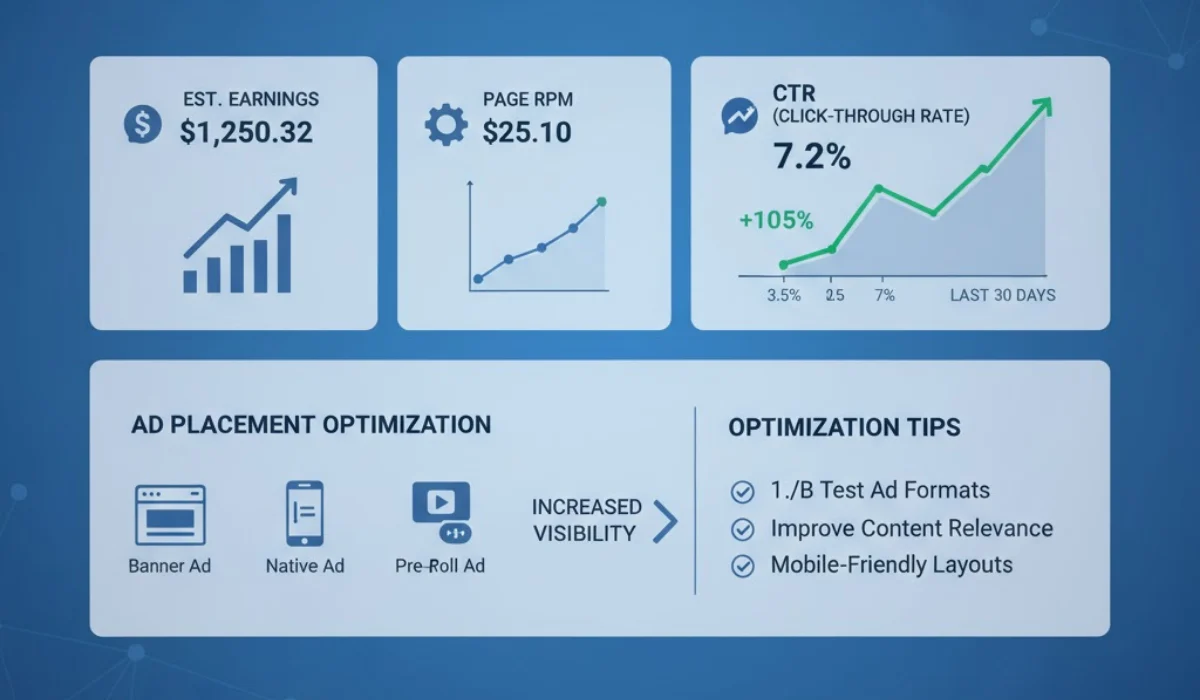Understanding AdSense CTR Fundamentals
Click-Through Rate (CTR) measures the percentage of ad impressions that result in clicks. For AdSense, it calculates as (Clicks / Impressions) x 100. A healthy range falls between 5% and 12%, depending on niche and traffic quality.
Higher CTR often correlates with elevated Cost Per Click (CPC), as engaged users attract premium advertisers. Google's policies cap excessive CTR to prevent invalid clicks, which can trigger ad limits or account suspensions.
In 2025, with mobile traffic dominating 60% of web visits, CTR optimization requires mobile-first strategies. Publishers report average CTRs of 1-2% industry-wide, but top performers exceed 10% through targeted tweaks.
Why CTR Matters for Revenue
AdSense earnings hinge on CTR and CPC interplay. For 100 page views with 100 impressions and 5 clicks, CTR hits 5%. Scaling this via better engagement multiplies income without inflating traffic costs.
Google's machine learning prioritizes user satisfaction, penalizing low-value sites. Maintaining optimal CTR ensures compliance and unlocks higher-value ad inventory.
Leverage AdSense Blocking Controls
AdSense's Blocking Controls feature allows publishers to filter out irrelevant or low-paying ads. This tool targets categories, specific advertisers, or URLs that underperform.
Low-bid ads from mismatched sectors reduce appeal, leading to fewer clicks. For a finance blog, blocking social media promotions like Facebook ads prevents dilution of relevant inventory.
Implementing Blocks Effectively
Access Blocking Controls via the AdSense dashboard under "Ads" > "By ad network." Start with general categories, monitoring performance over 7-14 days. Data shows blocking can lift CTR by 20-30% by prioritizing high-engagement ads.
Combine with URL blocking for persistent low performers. Google's guidelines limit blocks to avoid over-restriction, preserving ad variety. Regular reviews align blocks with audience shifts, sustaining gains.
In competitive niches like tech, where CPC averages $1-5, refined blocking elevates overall yields.
Optimize Ad Placements for Maximum Engagement
Ad placement drives CTR, as visibility influences clicks. Strategic positioning mimics content flow, blending ads seamlessly without overwhelming users.
Avoid overloading short posts, risking ad limits or speed penalties. Google permits ads based on content length, favoring longer articles for more units.
Recommended Ad Positions
Place the first ad before the title for immediate exposure. Follow with units before paragraph one, after paragraph three, and after paragraph six. End with post-content and pre-comment ads.
This "leaderboard" approach captures scroll behavior, with studies indicating above-the-fold ads yield 2-3x higher CTR. For mobile, responsive units adapt to screens, boosting accessibility.
Test via A/B variations, tracking via AdSense reports. Heatmap tools reveal user interaction hotspots, refining placements over time.
High-quality content integration prevents "Low Value Content" flags, ensuring ad eligibility.
Reduce Bounce Rate to Sustain Sessions
High bounce rates signal poor engagement, slashing impressions and CTR. Users landing and leaving quickly miss ad opportunities.
Internal linking anchors visitors, guiding them to related posts. Contextual anchors within content increase page views by 15-20%, per analytics data.
Speed Optimization Techniques
Enhance site speed with caching plugins, image compression, and minimal scripts. Core Web Vitals, Google's ranking factor, demand sub-2.5-second load times.
WordPress plugins like WP Rocket or LiteSpeed Cache optimize performance. Mobile optimization cuts bounces by 50% in responsive designs.
Lower bounces extend dwell time, exposing more ads and lifting CTR organically.
Conduct Keyword Research for Quality Content
Keyword research underpins content that retains users. Poorly targeted posts drive quick exits, harming CTR.
Tools like Google Keyword Planner or Ahrefs identify high-intent terms with low competition. Focus on long-tail keywords matching user queries.
Crafting Engaging Posts
Longer, value-packed articles (2000+ words) hold attention, allowing multiple ad impressions. Incorporate visuals, subheadings, and lists for scannability.
E-E-A-T principles—Experience, Expertise, Authoritativeness, Trustworthiness—align with Google's updates, favoring in-depth guides over thin content.
User retention metrics improve CTR as visitors explore, clicking contextually relevant ads.
Drive Organic Traffic Growth
Organic traffic fuels sustainable CTR, as search users arrive via intent-driven queries. Irrelevant traffic from bots or paid sources risks low engagement and penalties.
SEO best practices, including on-page optimization and backlink building, elevate rankings. Google's algorithm favors fresh, authoritative content.
Targeting High-Intent Audiences
Niche-specific keywords ensure ad relevance, with organic visitors clicking 2x more than social referrals. Aim for 1000+ monthly visitors before aggressive CTR pushes.
Analytics track traffic sources, prioritizing Google Search. Schema markup enhances rich snippets, boosting click-through from SERPs.
Consistent publishing schedules build authority, compounding traffic over months.
Limit Categories for Niche Focus
Multi-niche sites dilute ad relevance, lowering CTR. Fewer categories concentrate inventory on high-value ads.
Specialize in 1-3 topics, like finance or tech, to match user interests. Google's ad matching thrives on topical coherence.
Benefits of Niche Specialization
Narrow focus invites premium advertisers, elevating CPC alongside CTR. Data indicates single-niche sites achieve 8-15% higher rates.
Audit categories quarterly, merging or archiving underperformers. This streamlines navigation, reducing user friction.
Balance Ad Density Thoughtfully
Excess ads inflate impressions but dilute clicks, tanking CTR. Google enforces limits per page, tied to content volume.
Scale units to word count: 3-5 for 1000 words, up to 10 for 5000+. Prioritize quality over quantity.
Preserving User Experience
Overloading slows sites, spiking bounces. Google's Page Experience signals penalize slow loads.
Monitor via Google Search Console. Balanced density maintains speed, with AMP versions aiding mobile CTR.
Combine Auto and Manual Ads
Auto Ads use AI for dynamic placement, adapting to devices. Manual ads offer precision control.
Hybrid approach maximizes coverage: Enable Auto for experimentation, overlay Manual in proven spots.
Experimentation and Rotation
Rotate placements monthly, analyzing AdSense metrics. This identifies top performers, potentially raising CTR by 25%.
Disable underperformers promptly. Responsive units ensure cross-device consistency.
Advanced Monitoring and Compliance
Track CTR via AdSense dashboard, segmenting by device and geography. Alerts flag anomalies, preventing invalid activity.
Comply with policies: No click encouragement or ad cloaking. Regular audits safeguard accounts.
Tools for Optimization
Integrate Google Analytics for deeper insights. Third-party tools like AdSense plugins provide real-time dashboards.
A/B testing platforms simulate changes, forecasting impacts.
Case Studies and Benchmarks
Publishers report 10% CTR gains post-optimization. Finance niches average 7%, tech 5%, per industry benchmarks.
Long-term, consistent tweaks yield compounding results, with top sites sustaining 12% amid 2025 updates.
Conclusion: Sustained CTR Improvement
Implementing these strategies demands ongoing testing and adaptation. Prioritize user value, monitor metrics, and scale gradually for lasting AdSense success.




